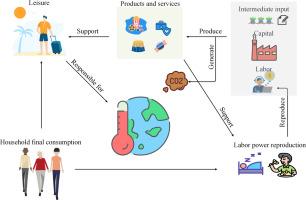Disparities and flows analysis of global leisure carbon footprints
IF 10.9
1区 环境科学与生态学
Q1 ENGINEERING, ENVIRONMENTAL
引用次数: 0
Abstract
Leisure is an important component of human life. Since human activities significantly contribute to global carbon emissions through final consumption, understanding CO₂ emissions embodied in leisure consumption is crucial for effective environmental management. Using a labor-closed environmentally extended input-output model, we assess the global leisure carbon footprint (LCF) for 2019, considering three leisure definitions. Results show that even under the narrow leisure definition, global LCF reaches 8 Gt, accounting for 18 % of global CO₂ emissions. Marked disparities in leisure consumption and LCF exist across countries. Based on countries’ per capita LCF, the top 10 % of the population contribute 30-40 % of total LCF, whereas the bottom half accounts for only 15-25 %. Furthermore, 32 %, 26 %, and 20 % of LCF under narrow, middle, and broad definitions are imported, with about two-thirds supporting leisure consumption in high-income countries. These findings offer a new perspective on carbon emission responsibility allocation across nations.

全球休闲碳足迹差异与流动分析
休闲是人类生活的重要组成部分。由于人类活动通过最终消费对全球碳排放做出了重大贡献,因此了解休闲消费中包含的二氧化碳排放对于有效的环境管理至关重要。利用劳动力封闭的环境扩展投入产出模型,我们评估了2019年全球休闲碳足迹(LCF),考虑了三种休闲定义。结果表明,即使在狭义的休闲定义下,全球LCF也达到8 Gt,占全球CO₂排放量的18%。各国在休闲消费和LCF方面存在显著差异。根据各国的人均LCF,前10%的人口贡献了总LCF的30- 40%,而后一半人口仅占15- 25%。此外,在狭义、中等和广义定义下,32%、26%和20%的LCF是进口的,其中约三分之二支持高收入国家的休闲消费。这些发现为各国的碳排放责任分配提供了新的视角。
本文章由计算机程序翻译,如有差异,请以英文原文为准。
求助全文
约1分钟内获得全文
求助全文
来源期刊

Resources Conservation and Recycling
环境科学-工程:环境
CiteScore
22.90
自引率
6.10%
发文量
625
审稿时长
23 days
期刊介绍:
The journal Resources, Conservation & Recycling welcomes contributions from research, which consider sustainable management and conservation of resources. The journal prioritizes understanding the transformation processes crucial for transitioning toward more sustainable production and consumption systems. It highlights technological, economic, institutional, and policy aspects related to specific resource management practices such as conservation, recycling, and resource substitution, as well as broader strategies like improving resource productivity and restructuring production and consumption patterns.
Contributions may address regional, national, or international scales and can range from individual resources or technologies to entire sectors or systems. Authors are encouraged to explore scientific and methodological issues alongside practical, environmental, and economic implications. However, manuscripts focusing solely on laboratory experiments without discussing their broader implications will not be considered for publication in the journal.
 求助内容:
求助内容: 应助结果提醒方式:
应助结果提醒方式:


